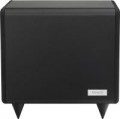Acoustic design
—
Closed type. The simplest type of construction: a closed (sometimes hermetically sealed) case with a speaker placed on the front panel. It is believed that such subwoofers have low sensitivity, which, however, is offset by high sound transmission accuracy and low distortion.
—
Phase inverter type. In the cases of such subwoofers, a tube is installed that has an outlet to the surrounding space. The length of the tube is chosen so that a signal comes out of it, inverted in phase relative to the signal from the front of the cone (in other words, from the main speaker). This improves the sound of the subwoofer and enhances the sound pressure. The disadvantage of a phase inverter is the additional noise from the sound stream in the tube.
—
With a passive radiator. A design similar to a phase inverter (see above) in terms of purpose and principle of operation, however, instead of a tube, such subwoofers use the so-called passive emitter. In fact, it is an ordinary speaker, devoid of a coil and a magnet and playing the same role as the phase inverter tube. The use of a passive radiator allows you to get rid of the noise of the air flow, characteristic of phase inverters.
Power
Rated power of the subwoofer. Technically, this is the highest average (rms) sound power at which the device can work normally (without sound distortion and damage to components) for an unlimited time. Simply put, the more powerful the subwoofer, the louder it is. The choice for this parameter depends primarily on the size of the space / room that is planned to be covered; detailed recommendations for different situations can be found in special sources.
Also, the power is directly related to the characteristics of the amplifier used with the subwoofer. For active subwoofers (see "Type"), this item actually indicates the nominal power of the built-in amplifier; the speaker itself can be more powerful, but it doesn't matter anymore. For passive models, the power rating corresponds to the highest amplifier power that can be connected to the speaker without the risk of damaging it at high volume.
Frequency range
The range of audio frequencies reproduced by the subwoofer. As a general rule, the wider the frequency range, the richer the sound and the more detail the speaker can convey. However, it is worth remembering that subwoofers as a class are designed for low and ultra-low frequencies in the range from 20 to 150 (sometimes 200) Hz. Therefore, in fact, a significant difference in sound is noticeable only with a large difference in the reproducible ranges (for example, 20-200 Hz and 50-150 Hz).
Also, do not forget that an extensive frequency range is not yet a guarantee of high-quality sound; and in some cases (for example, if the main speakers of the speaker also cope well with low frequencies), it may be completely redundant.
Adjustable crossover
The presence of an
adjustable crossover in the design of the subwoofer.
A crossover is a device that divides the audio signal into separate frequency bands and directs each band to "its own" speakers. See "Crossover Frequency" for more on this. Here we note that the adjustable crossover allows you to change the upper threshold of the frequencies supplied to the subwoofer. This allows you to optimally match the bass speaker with the main speakers — so that, on the one hand, the bass does not overlap, on the other, there is no gap between the subwoofer and the rest of the acoustics.
Crossover frequency
Cutoff frequency of the crossover installed in the subwoofer (or supplied with it — for passive models, see "Type").
The crossover splits the audio signal into separate frequencies so that only the bass goes to the subwoofer and only the main range goes to the speakers. Such a device is mainly equipped with home models (see above). And the crossover frequency is the upper threshold of the frequencies fed to the subwoofer. This information is important for matching with the rest of the speakers: ideally, the lower threshold of the main acoustics should correspond to the upper threshold of the subwoofer, otherwise the frequencies will either overlap or dip in them (neither of which contributes to sound quality). For the convenience of matching, the crossover can be made adjustable (see above).

